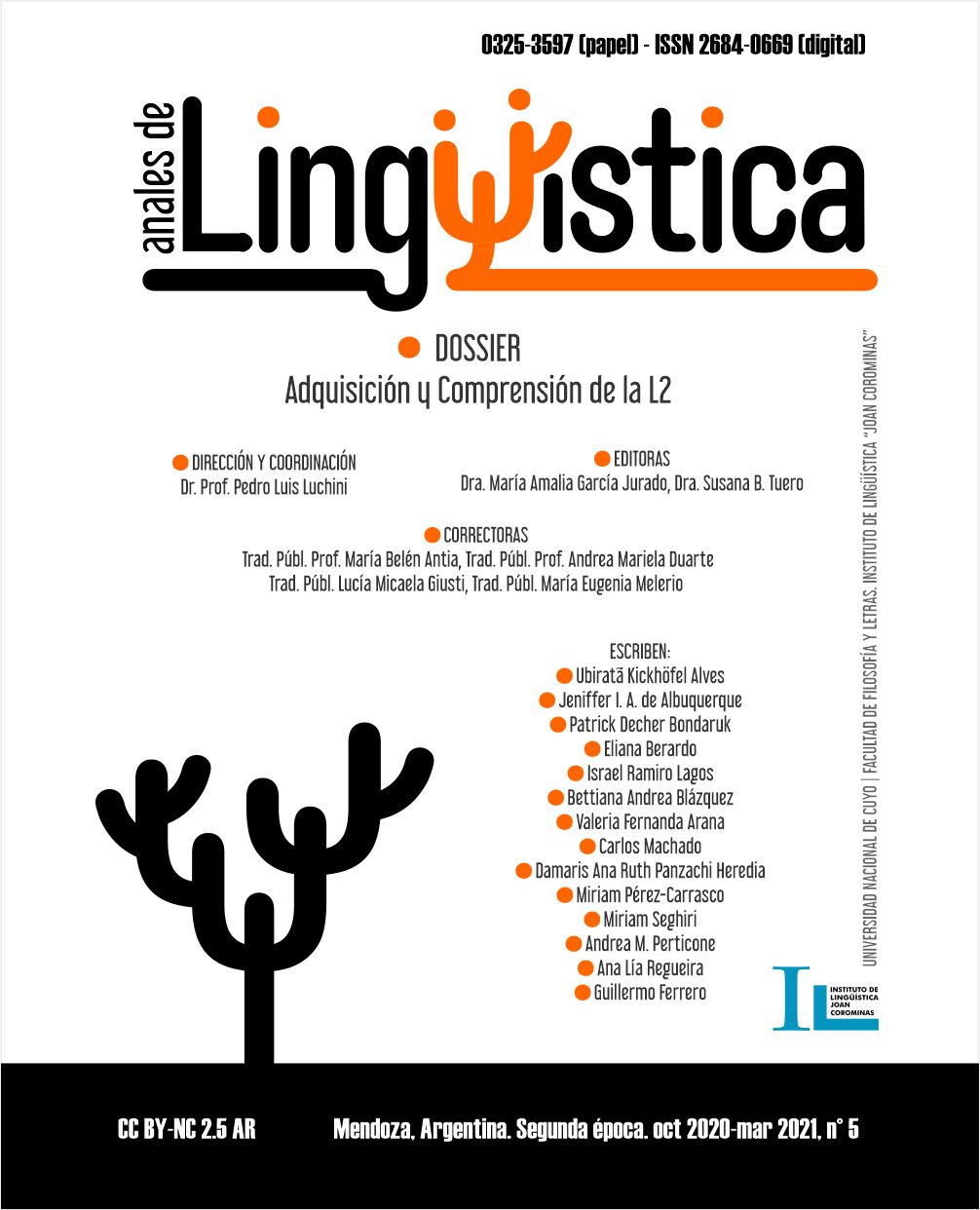Nucleus placement in spanish as L1 and english as L2: comparative study of reading aloud of argentinean university students
Keywords:
nuclear accent, pragmatics, Spanish L1, English L2, reading aloudAbstract
The purpose of this article is to present some results which have been obtained through a comparative study of two previous pieces of research carried out at Facultad de Lenguas (FADEL), Universidad Nacional del Comahue (UNCo). Both studies analysed where the nuclear accent is placed in university students’ oral production, both in Spanish (L1) and English (L2). The participants were students of the English Translator and English Teacher Training Courses. As regards the first stage of the research, the subjects of study were elementary students of the target language (L2), whereas in the second phase, the participants were advanced students of English. The corpus was obtained from the students’ reading of a story in English as well as from the reading of its translation into Spanish. Different cases of deaccented and/or reaccented material of given information in final position in the intonational phrase have been examined as a phenomenon connecting phonology and pragmatics.
The results suggest that the theoretical and practical instruction of the accentual patterns of the target language affects the students’ choice of nuclear accent when reading aloud, both in Spanish (L1) and English (L2).
References
Blázquez, B., Arana, V., Siegel Masías, C. y Torres, E. A. (2015). Expresión prosódica del estatus de la información en estudiantes argentinos del inglés como lengua extranjera. En: P. Luchini, M. A. García Jurado y U. Kickhöfel Alves (Eds.). Fonética y fonología: articulación entre enseñanza e investigación. (pp. 344-357). Mar del Plata: Universidad Nacional de Mar del Plata.
Blázquez, B., Arana, V. y Torres, E. A. (2016). El acento nuclear en inglés: análisis de producción de estudiantes universitarios argentinos. En: U. Kickhöfel Alves (Ed.). Aquisição fonético-fonológica de língua estrangeira: investigações rio grandenses e argentinas em discussão (pp. 419-437). Campinas: Pontes Editores.
Boersma, P. y Weenink, D. (2010). Praat: Doing Phonetics by Computer (Versión 5.1.31) [Computer software]. http://www.praat.org/
Castilhos Schereschewsky, L., Kickhöfel Alves, U. y Flores Kupske, F. (2017). First Language Attrition: The effects of English (L2) on Brazilian Portuguese VOT patterns in an L1-dominant environment. Revista Digital do Programa de Pós-Graduação em Letras da PUCRS, 10 (2), pp. 700-716. http://dx.doi.org/10.15448/1984-4301.2017.2.26365
Estebas Vilaplana, E. (2009). Teach Yourself English Pronunciation. An Interactive Course for Spanish Speakers. Oleiros: Netbiblo.
Gabriel, C., Feldhausen, I., Pešková, A., Colantoni, L., Lee, S., Arana, V. y Labastía, L. (2010). Argentinian Spanish Intonation. En: P. Prieto y P. Roseano (Eds.). Transcription of Intonation of the Spanish Language (pp. 285-317). München: Lincom.
Ladd, R. (2008). Intonational Phonology. (2.a ed.). Cambridge: Cambridge University Press.
Halliday, M. (1967). Intonation and Grammar in British English. The Hague: Mouton.
Hualde, J. I. (2003). El modelo métrico-autosegmental. En: P. Prieto (Ed.). Teorías de la entonación (pp. 155-184). Barcelona: Ariel.
Hualde, J. I. (2014). Los sonidos del español. Cambridge: Cambridge University Press.
House, J. (1990). Intonation Structures and Pragmatic Interpretation. En: S. Ramsaran (Ed.). Studies in the Pronunciation of English (pp. 38-57). London: Routledge.
Pierrehumbert, J. (1980). The phonology and phonetics of English intonation [Disertación doctoral, Massachusetts Institute of Technology]. DSpace@MIT. https://dspace.mit.edu/handle/1721.1/16065
Prieto, P. (2005). En torno a la asociación tonal en el modelo métrico-autosegmental. Puntos controvertidos en su aplicación al catalán. Revista Internacional de Lingüística Iberoamericana, 6 (3), pp. 9-28.
Prieto, P. y Estebas Vilaplana, E. (2008). La notación prosódica del español: una revisión del Sp-ToBI. Estudios de fonética experimental, 17, p. 263-283.
Sperber, D. y Wilson, D. (1995). Relevance, Communication and Cognition. (2.a ed.). Oxford, Reino Unido y Cambridge, Estados Unidos: Blackwell.
Sperber, D. y Wilson, D. (2004). Relevance Theory. En: L. Horn y G. Ward (Eds.). The Handbook of Pragmatics (pp. 607-632). Oxford: Blackwell.
Wilson, D. y Wharton, T. (2006). Relevance and Prosody. Journal of Pragmatics, 38, pp. 1559-1579.
Thomas, V. y Paul, K. (2007). Winnie the Witch. Oxford: Oxford University Press.
Thomas, V. y Paul, K. (2012). La bruja Winnie. Versión en español. Barcelona: Océano.
Downloads
Published
How to Cite
Issue
Section
License
Copyright (c) 2021 Anales de Lingüística
Esta obra está bajo una Licencia Creative Commons Atribución 2.5 Argentina.
Los/as autores/as que publican en esta revista están de acuerdo con los siguientes términos:
1. Los/as autores conservan los derechos de autor y garantizan a la revista el derecho de ser la primera publicación del trabajo bajo una licecncia Creative Commons Atribución 2.5 Argentina (CC BY 2.5 AR) . Por esto pueden compartir el trabajo con la referencia explícita de la publicación original en esta revista.
2. Anales de lingüística permite y anima a los autores a difundir la publicación realizada electrónicamente, a través de su enlace y/o de la versión postprint del archivo descargado de forma independiente.
3. Usted es libre de:
Compartir — copiar y redistribuir el material en cualquier medio o formato
Adaptar — remezclar, transformar y construir a partir del material para cualquier propósito, incluso comercialmente.












